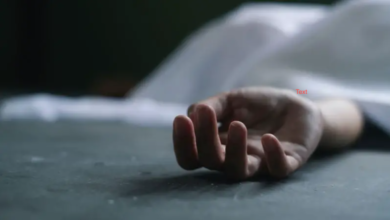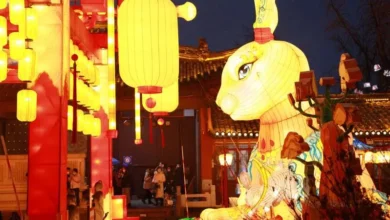‘A tipping point’?: Why this 1768 painting could be the real birth of modern art
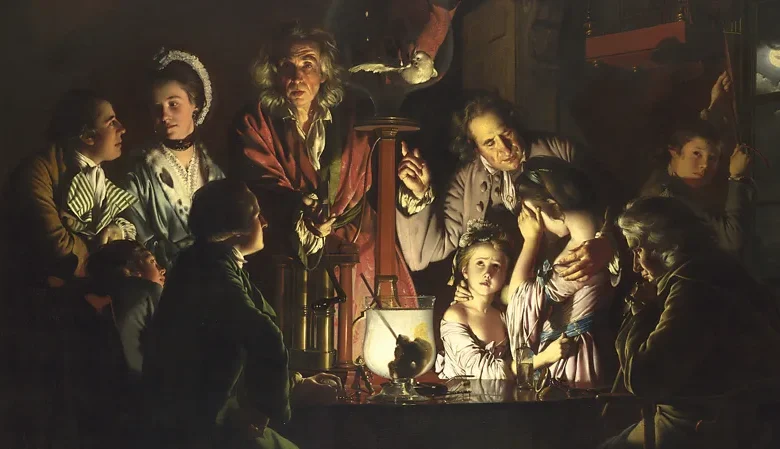
While many argue that “modern art” began in the 1800s, could it actually have started with Joseph Wright of Derby’s An Experiment on a Bird in the Air Pump, nearly a century before?
What is “modern art”? It seems like a simple question, but critics and art historians have quarrelled about it for decades without agreement. Nor is there any consensus about which artwork marks the turning point between “traditional” and “modern”.
Many point to the 1800s – and paintings like Le Déjeuner sur l’Herbe (1863) by Édouard Manet, Rain, Steam, and Speed – The Great Western Railway (1844) by JMW Turner, and The Third of May 1808 (1814) by Francisco Goya, who was described by the art critic Robert Hughes as “the first modern artist and the last old master”.
A new exhibition at the National Gallery in London reminds us that there is another contender in the ring. It’s a painting that has some of the key ingredients of modern art, decades ahead of its time: Joseph Wright of Derby’s An Experiment on a Bird in the Air Pump (1768).
This was a world that didn’t tend to separate art and science, they tended to be seen as one and the same thing – Christine Riding
It depicts a science experiment. Oxygen is being pumped out of a glass vessel containing a white cockatoo. Spectators, cloaked in the peripheral darkness, are transfixed by the life-or-death drama unfolding in front of their eyes. Wright has orchestrated his scene to as a chain reaction, with a pivotal event at the centre sending shockwaves of emotion through the spectators.
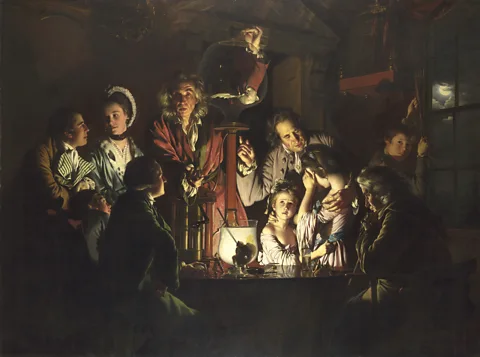 The National Gallery, London
The National Gallery, LondonAt the centre is a scientist with one hand on the valve which allows air in and out of the glass container. On the table is the air pump. The spectators react to the spectacle of the suffocating bird in different ways. On the left, a young couple seem more interested in checking each other out than the experiment. On the right, two young girls react in horror at the act of animal cruelty. The men nearest us seem able to control their horror. A young boy in the back lowers a curtain to block out the moonlight. The other light source in the scene is a lantern in the centre, hidden behind a jar containing a human skull.
So, what exactly is “modern” about this scene?
Mixing the old and the new
First there is Wright’s remixing of art historical tradition, taking familiar poses and lighting techniques and repurposing them for a contemporary scene.
This is something that the French poet and critic Charles Baudelaire would declare as a defining feature of modern painting in his essay The Painter of Modern Life in 1863: blending the “ephemeral” changeability of the modern world with the solid, “eternal” qualities of great art from the past. Édouard Manet exemplified this approach in Le Déjeuner sur l’Herbe (1863) which depicted a modern-day picnic but with figures based on Raphael’s Renaissance artwork The Judgment of Paris (1510-20).
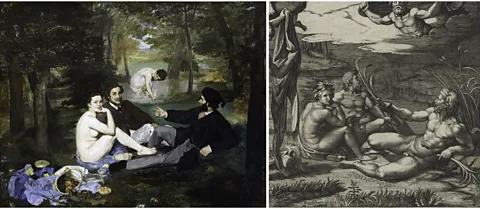 The Metropolitan Museum of Art
The Metropolitan Museum of ArtBut Wright can be seen doing this almost 100 years earlier. In An Experiment on a Bird in the Air Pump, Wright riffs on canonical scenes depicting religious miracles. A striking comparison can be made with Caravaggio’s Supper at Emmaus (1601), which is also on display at the National Gallery.
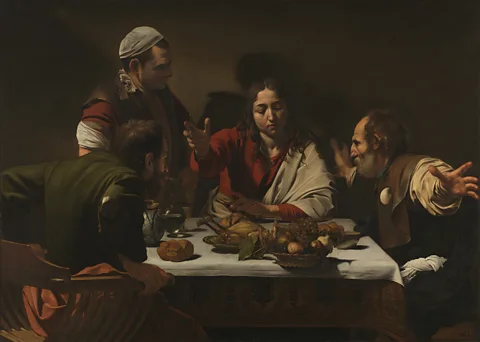 The National Gallery, London
The National Gallery, LondonThe exhibition’s curator, Christine Riding thinks that Wright developed his Caravaggio-like handling of light and dark because the London art world at the time was so competitive. “He was entrepreneurial and came up with a signature style. And I don’t think anyone dared do the same because he was so good at it – it became his USP.”
And while air pumps had been devised way back in 1650, the spirit of sharing scientific truths democratically was modern. “The dissemination of knowledge,” Riding tells the BBC, “was a new thing to the 18th Century.”
Depictions of modern life
And this brings us to the second ingredient of modern art – the representation of modernisations in society. Normally, this breakthrough is credited to pioneering artists in the 1800s such as JMW Turner.
Christine Riding believes that Wright’s innovation in this area was inspired by changing exhibition opportunities for artists in Britain at the time. Before the creation of a Royal Academy, artists had the choice of several competing display venues. One of them was the Society of Artists of Great Britain, where An Experiment on a Bird in the Air Pump was first displayed to the public. “The Society of Artists encouraged arts, science, and manufacture,” Riding says. “This was a world that didn’t tend to separate art and science, they tended to be seen as one and the same thing.”
Wright decisively exploited this new art scene and its encouragement of cross-disciplinary thinking. It inspired him to make science the subject of art. This also mirrored wider changes occurring in 18th-Century society, such as the Industrial Revolution, which was just beginning to gear into action in Great Britain, and whose epicentre was the Midlands, Wright’s place of birth. And Wright was clever enough to recognise the spirit of modernisation and record it for posterity.
He even knew some of the preeminent figures of this momentous era, including members of the Lunar Society of Birmingham, which met to discuss scientific and industrial innovation, and Richard Arkwright, the foremost entrepreneur of the Industrial Revolution.
So, Wright reflects a modern state of mind in An Experiment on a Bird in the Air Pump. Even contemporary critics recognised that Wright’s approach was significantly different to his artistic peers’. When the painting was first displayed, the Gazetteer called the artist “a very great and uncommon genius in a peculiar way”. We may raise an eyebrow at the word “peculiar” nowadays, but in the 18th Century it was meant to express extraordinariness.
But he did not necessarily match it with an extraordinary painting technique. His Caravaggio-like style was firmly of the 17th Century, like the air pump itself. This is a key difference with other artworks claimed as “modern” in the 19th Century. JMW Turner’s Rain, Steam, and Speed – The Great Western Railway (1844), for example, similarly depicted technological progress and its impact on society, but importantly, it also set forth a brilliantly innovative new way of depicting light, depth, smoke, steam and motion in oil paint.
And it’s this surrender of realism in exchange for expressionism and abstraction which is often claimed as a key feature of modern art, later to be innovated even further by such artists as Hilma af Klint and Kandinsky, and many others through the 20th Century and beyond.
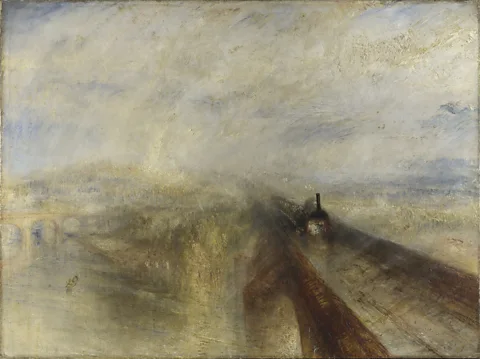 The National Gallery, London
The National Gallery, London‘Doubt and scepticism’
Ultimately, it was Wright’s “questioning, doubt and scepticism” that is the critical aspect of his modernity, according to Christine Riding.
An Experiment on a Bird in the Air Pump lacks a simple, uplifting moral message. In the composition, the central figure’s left hand is poised to open or seal the valve on the glass container. His right hand is gestured outwards openly to the viewer, as if to ask our opinion about the choice between life and death.
This remains a strikingly contemporary dilemma: how to handle the terrible powers unleased by science and technology. It concedes that the knowledge gleaned from human progress can be used for both good and evil.
This is a theme commonly associated with Francisco Goya, in particular The Disasters of War (1810-1814), his series of etchings about the Napoleonic invasion of Goya’s homeland of Spain. These images are often described as a turning point in art history – the first time that an artist revealed the inner darkness of humanity with unflinching directness and offering a disquieting scepticism about human progress.

During the Enlightenment period (roughly 1680-1820) it was hoped that scientific reason, democracy and the rule of law would revolutionise and improve society. Goya’s art seems to be a solemn and pessimistic rebuttal of this hope.
But Wright’s painting provides an earlier utterance of the same concern. It’s there in the fearful look on the young girl’s face, and the icily fretful expression of the white-haired man in silhouette.
These details and wider context might make us think differently about An Experiment on a Bird in the Air Pump. But, overall, can we claim it as the first work of modern art?
Although seemingly quite different from avant-garde art of the 19th and 20th centuries, it is undoubtedly an important early attempt to respond to a modernising world. It paid homage to tradition but depicted contemporary life, it engaged directly with modern issues, reflecting wider changes in society, and it conveyed a scepticism about progress – all of which would be essential characteristics of the next century’s “modern” art.
Whether Wright’s work was a true tipping point remains contentious. He was not a diehard traditionalist, but neither was he a fully-fledged modern. He sits just on the cusp of art’s transformation from being a vehicle of tradition to being an arena for the shocks of the new.

